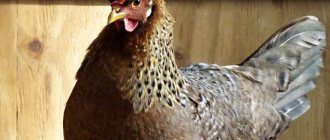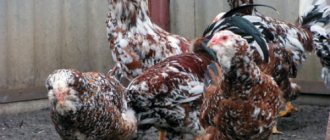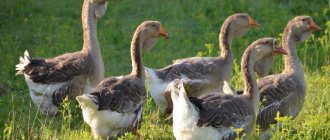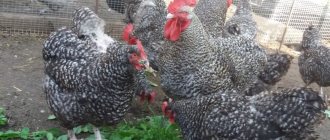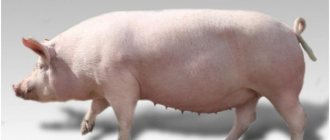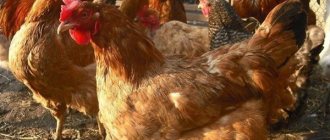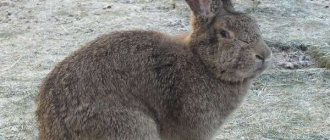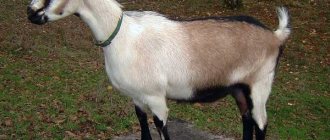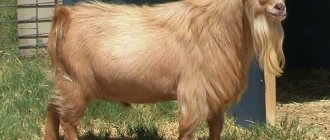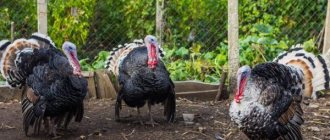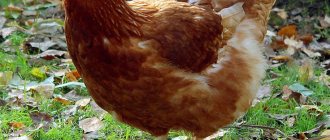Poultry farming » Turkeys
0
1827
Article rating
Kira Stoletova
Turkey is the favorite meat among poultry. There are several breeds that are bred for people on farms. However, maintaining a pure line of birds is not always profitable, which is why breeders buy crosses for themselves. Such birds are characterized by an increased level of health, as well as improved characteristics. Bronze 708 turkeys are considered a prominent representative among hybrids.
Description of turkeys of the Bronze 708 breed
Broilers of this breed are characterized by rapid early maturity and good egg production. Large enterprises prefer to purchase such turkeys, since birds of this origin are intended for slaughter and are not suitable for long-term breeding.
Pure breed turkeys and crosses
Before you get turkeys, you should choose a breed of bird. There are official lines of turkeys that are suitable for breeding. A purebred breed guarantees that all the characteristics of the parents are passed on to the chicks. However, over time, inbreeding leads to degeneration of the bird. Turkey poults are born weak, they often have genetic malfunctions and defects. During inbreeding, turkey eggs are small in size and watery, and the meat loses its taste. To avoid family ties, you should purchase birds of the same breed, but from a different line or cross, which will dilute the blood.
However, it must be remembered that crosses are poorly suited for pure breeding due to recessive genes. Turkey poults may not match the characteristics of their parents, so it is better to breed crosses with a pure breed.
Bronze broad-breasted turkeys were created in America by crossing wild birds and the English black turkey. This breed has “premium class” status in its homeland, as it is distinguished by good weight, beautiful plumage and stable egg production. English scientists, through selection, improved the existing characteristics and obtained a line called Orlopp Bronze. By crossing this species with the main breed, scientists in France obtained the medium-heavy cross Bronze 708.
Due to their large size, bronze broad-breasted turkeys are used as the basis for creating hybrids. In addition to the 708 cross, the following lines were bred using this breed:
- Beltsville;
- North Caucasian bronze;
- Grelevitskaya;
- Moscow bronze.
However, the 708 cross is considered the most profitable investment, since this breed gains weight very quickly and pays off its cost.
Diseases
Most often, bronze crosses are affected by infectious diseases: mycoplasmosis, pullorosis, Newcastle disease, and also suffer from pathologies of bone tissue, which leads to deformation of the limbs.
- Parasites
- Infectious
- Other
Worms
Roundworms (helminths) that cause various diseases and, as a result, serious disorders in the body of birds
Read
Coccidiosis
How to identify the disease and how to treat it? What is important to know about prevention?
Read
Smallpox
Causes, symptoms of various forms, preventive measures and treatment methods
Read
Hemophilosis
A dangerous respiratory disease that can lead to the death of the entire livestock
Read
Histomoniasis
Forms of pathology, symptoms, diagnosis and treatment
Read
Pullorosis
Description of the disease, symptoms, treatment, preventive measures
Read
Salmonellosis
Salmonellosis (paratyphoid): symptoms of acute and permanent forms of the disease, treatment and prevention
Read
Newcastle disease
What is it and how to avoid infection? Main characteristics of the disease
Read
Mycoplasmosis
Symptoms and treatments for this disease, as well as measures to prevent epidemics
Read
Rickets
A chronic disease characterized by impaired calcium-phosphorus metabolism
Read
Appearance of turkeys cross 708
The description of the appearance of this breed of bird meets the high standards set by poultry farmers. Broad-breasted bronze turkeys are distinguished by such features as:
- Large body sizes.
- Bronze olive plumage.
- Sturdy body.
- Medium length neck.
- Blue skin on the head and neck.
- Strong legs with a wide stance.
Turkeys have cover feathers on their shoulders that end in a white border. On the back of females there are dots of the same color. The tail of turkeys cross bronze 708 is fan-shaped, wide. A sign of the breed is considered to be black stripes along the back.
Weight gain in the bronze breed 708
Thanks to their hybrid origin, cross bronze 708 turkeys are resistant to many diseases and begin to gain weight early. The meat of this breed is of high quality and dietary. It is prescribed to people with diseases of the gastrointestinal tract or heart defects.
Young animals slaughter at the age of five to six months. By this time, the turkey can already weigh from ten to seventeen kilograms.
This breed is capable of gaining a lot of weight, however, this is not profitable for the poultry farmer, since feeding an adult turkey is quite expensive. Cases have been recorded where males weighed more than thirty kilograms.
conclusions
Turkeys bronze 708 – cross. They have plumage of a beautiful noble bronze hue, which distinguishes them very favorably from other breeds. In addition, it is characterized by the following exterior and productive indicators:
- Fast weight gain with low feed costs.
- High egg production and good incubation abilities of turkeys. The weight of the eggs is about 100 grams, and their fertilization rate is up to 80%.
- Delicious dietary meat that can be obtained from young animals 4 months old. It is by this time that most individuals are ready for slaughter.
- The disadvantage of the cross may be a slightly unsatisfactory presentation when slaughtered at an early age, since dark stumps remain on the carcass.
Egg production of the breed
Bronze 708 turkeys are characterized by high egg production. One female can lay from seventy to one hundred and fifty eggs per year. Turkeys begin to lay eggs steadily by the tenth month of life. With the onset of winter, birds do not lose this ability, so they are well suited as a replacement for chickens.
Bronze 708 turkey eggs are distinguished by their high taste and large size. Many chefs value them for their creamy cheese flavor, which complements dishes perfectly.
The eggs of this type of turkey are very large
Turkeys of this species have a developed maternal instinct, which is not typical for hybrids. Females are often given eggs from ducks or chickens. This is beneficial to farmers, since the size of the bird allows it to hatch a large clutch.
Bronze 708 turkeys do not require artificial insemination. Males are ready to mate between 1 and 4 years of age, and female turkeys begin to hatch eggs at 2 years of age.
For breeding to be successful, it is better to breed 708 crosses with representatives of the same line. You should not mix hybrids with each other - because of this, the chicks hatch weak and incapable of life.
If the mating is successful and at least one of the parents has dominant genes, then up to 80% of the eggs are fertilized, and approximately three-quarters of the turkey poults are born from the entire clutch. Almost all chicks survive due to stable health, so the growth rate of these birds on the farm is fairly stable.
Productivity
Productivity in poultry consists of two indicators: egg production and live weight. They depend on the breed, living conditions, feeding and timely preventive measures aimed at preventing diseases. Turkey cross 708 is a broiler type. They have good meat quality and grow quickly. They differ from other breeds in their greater live weight and good egg production. When kept on poultry farms, subject to proper rearing standards, broilers can reach a weight of about 30 kilograms. This indicator will not be present when fattening on homestead farms.
Meat output and weight gain
The breed is distinguished by its large mass. In homestead livestock farming conditions, the weight of a turkey can reach 18 kilograms, and a turkey - nine. By four months of fattening, you can get 8 kilograms of dietary meat. The slaughter of turkeys begins at this age, and turkeys can be slaughtered a month and a half later. By that time they gain from 14 to 17 kilograms. There were, of course, cases where in industrial conditions the weight of a bird reached 25–30 kilograms, but at home such a result is practically impossible to achieve.
The longer you raise a bird, the faster your feed consumption increases, and raising turkeys becomes an irrational activity.
Egg production
Read about incubating turkey eggs here.
Nests should be built in a shaded place, away from lighting and drafts.
Disadvantages of turkeys of the bronze breed 708
Positive reviews from poultry farmers indicate the demand for turkeys of the Bronze 708 breed, however, the 708 cross has certain disadvantages:
- Since 708 crosses are broilers, they require a special enclosure to restrict movement. Broad-breasted turkeys can be released for grazing, however, in this case, the birds gain less weight and lose egg production.
- Due to too bright plumage, black spots often remain on the skin after plucking. This reduces the cost of the carcass when sold.
- If, during crossing, both parents of turkey chicks turn out to be hybrids, then the chicks may have bent bones or disorders of the muscular system. This occurs due to a genetic failure. Sometimes the cause of such defects can be poor nutrition or the consequences of infections. If a bird's skeleton is bent, its feathers are not growing well, or its beak is crumbling, it should not be allowed to mate.
Keeping a cross at home
First of all, a poultry house and an aviary for walking should be organized for these large birds. The turkey coop must be built warm and airtight; these birds cannot tolerate drafts.
The floor of the house should be twenty-five centimeters above the ground. The dwelling is covered with wooden boards and covered with straw or sawdust. A thin layer of lime is additionally applied under this bedding.
There are additional features that should be considered when building a poultry house:
- The windows of the turkey house should be large and facing south to allow daylight to enter the room.
- The temperature in the poultry house should not fall below five degrees and exceed twenty-five degrees.
- Turkeys are very sensitive to sunlight and during the cold season additional light sources should be placed indoors.
- The nests should be located in the corner farthest from the door at a height of half a meter.
- Perches are installed in a dark place.
The poultry house is built based on calculations of three square meters per turkey. To avoid fights for territory, the turkey poultry is divided by partitions, placing several females and one male separately.
Turkeys need to periodically clean their feathers to remove parasites. For this purpose, special containers with sand or ash are installed in the poultry house.
To reduce the risk of poultry disease, sanitary standards should be followed. The turkey poultry is cleaned once every two weeks. Every season, the entire room should be treated with a soda solution or other disinfectants.
Bronze 708 turkeys definitely need an aviary for walking. To do this, you need to install a canopy, fence off the area with a net and sow it with fodder grass.
Breeding
For this breed, two methods of breeding new offspring are used, each giving a positive result.
Incubation
To obtain healthy and strong chicks, it is necessary to select high-quality and fresh eggs. Each specimen should be carefully examined under an ovoscope. When viewed under this device, the yolk should move smoothly and slowly. The optimal age of material for placing in an incubator is 6-7 days.
The second stage of preparation is heating the eggs to 20°C. Heat gradually so that condensation does not form on the surface. Next, they are placed in a machine equipped with automatic egg turning.
It is important that the incubator has stable temperature and humidity.
Under optimal conditions, the chicks will be born in 27-28 days. After drying, they are placed in cardboard boxes. Set the temperature within 29-30°C and provide good lighting using artificial light lamps.
Natural method
Many breeders practice natural brooding of turkey poults. For this purpose, turkeys with a calm character and a pronounced incubation instinct are selected. 15-17 eggs are placed under one hen.
A week later, the eggs are examined under an ovoscope, and unfertilized eggs are removed and disposed of. On day 26, specimens with frozen embryos are removed. Chicks are collected as they hatch from the 27th-28th day of incubation, after complete drying.
Turkey poults who cannot get out of the egg on their own need help - carefully break off the shell at the peck site.
The next day, the chicks can be placed with the hen. She will take good care of them for 1-1.5 months.
Diet for feeding cross-breeds
The bird is gaining weight quickly
Turkeys of this species are prone to rapid weight gain, however, to do this they need to eat high-calorie foods. Usually, various feeds based on grain crops are used to feed cross-breeds. Experienced farmers make individual bird feeds, but there are also ready-made mixtures.
A balanced diet should contain a complex of vitamins and minerals. Without them, the bird's growth slows down and its health level plummets. Vitamin supplements include:
- fish fat;
- cake;
- bone flour.
To properly feed a cross in winter, you should prepare some ingredients in advance. Among them are:
- forb hay;
- sauerkraut;
- herbal flour;
- a mixture of nettles, alfalfa and colza.
For better absorption of food, chalk, gravel and small shell rock are added to the feeder.
To improve the egg production of turkeys, reduce the amount of feed in the diet and add fresh herbs and vegetables. Also, to increase calcium in the body, laying females need to be given dairy products. Otherwise the egg will be fragile and watery. There is a table of the required daily intake of beneficial minerals and vitamins that inexperienced breeders should consult.
The daily diet of the average cross 708 looks like this:
- Compound feed – 80 grams.
- Oat bran – 50 grams.
- Animal waste – 100 grams.
- Pure grain – 250 grams.
- Vegetable products – 50 grams.
- Shell rock, salt and bone meal - 25 grams.
To fatten the boilers, the daily grain intake needs to be increased. At 4 months, one boiler eats two kilograms of food.
Some breeders claim that special mixtures can be replaced with more common analogues. For example, feed for pigs is also high in calories, and very often laying turkeys that have already lost their egg production are switched to this feed. This allows the bird to gain the required weight in the shortest possible time. The average weight of laying females is from 5 to 8 kg, but with the help of proper fattening this figure can be increased to 9, sometimes up to 15 kg of pure meat.
On the contrary, they try to keep breeding males and females on a strict diet, since excess weight reduces the reproductive capacity of the animal.
The feeding regime must be strictly observed, otherwise the crosses begin to get nervous and lose weight due to stress. In addition, hunger has a bad effect on the character of turkeys - their level of aggression increases and the birds begin to pose a danger to other individuals.
The best way to feed birds is with bunker type feeders. In this case, the minimum amount of food goes to waste, and the turkeys themselves eat as much as they want. In addition, this feeding method requires minimal effort from the farmer and is suitable for large farms with semi-automatic maintenance.
Features of the diet of turkey poults
The diet for chicks differs from the diet of adults. Incorrectly selected nutrition for small crosses can cause death. On the first day, the chicks are fed a boiled egg. Sugar or glucose solution should be added to drinking water for turkey poults.
The daily diet in the first month of life of the 708 crosses looks like this:
- Wet grain mash.
- Fresh vegetables.
- Fruits.
- Greenery.
- Sprouted oats.
- Protein food.
- Complex of vitamins and minerals.
If you follow the diet, then Bronze 708 turkey poults will quickly grow and by the third month of life they can be switched to regular food along with adults.
Nutrition
Proper and balanced nutrition will provide the entire herd with good immunity against disease and increase productivity.
Food for adults:
- Dry mixtures (compound feed). They contain all the components necessary for growth and development.
- Wet mash. They are prepared from several ingredients - ground grains, corn, grass, root vegetables, cake. Moisture is provided by the broth obtained by boiling the bones. You can also moisten the dry mixture with water. With this type of feeding, additionally crushed grains are given - wheat, barley, oats or corn. They should make up 40% of the daily diet.
Cottage cheese, bone meal, fresh herbs, crushed eggshells, shells, and wheat bran are also mixed into the food.
Feed must be balanced
In addition to the main food, the bird is given vital microelements - sodium, phosphorus, potassium, as well as amino acids (cystine, lysine, arginine, histidine, tryptophan). They ensure full growth and development of both adults and young animals.
In the winter season, when there is a lack of succulent and nutrient-enriched feed, sauerkraut, nettles, and fortified flour based on pine needles are introduced into the diet.
In addition to properly selected food, you need to provide clean and fresh drink. To supply water, it is better to use vacuum drinkers, through which dirt does not penetrate and the water always remains clean.
Diet of chicks
- The first 6 days - give crushed boiled egg. It can be mixed with low-fat cottage cheese. Feed every 2-2.5 hours.
- From day 7 - give a mixture of finely chopped greens, boiled eggs with the addition of cottage cheese. Additionally, add 10-15 g of boiled, grated potatoes, a little feed yeast, and chopped peas. Feeding frequency - 6-8 times a day. Turkey poults are very fond of green onions, which are served to them in the first half of the day.
- From day 14 they stop producing eggs. The basis of nutrition is crushed oats. It is topped with yogurt, skim milk or skimmed milk. Increase the amount of greens - 15-20 g per individual per day. Legumes - chopped peas and soybeans - are also mixed into the feed. They contribute to the full development of the musculoskeletal system in chicks.
- By day 30, eliminate the cottage cheese, leaving only the skim milk for preparing wet mash. Also given are crushed grains, wheat bran, whole oats and barley.
- From 2 months, the chicks begin to gain muscle mass, so crushed corn, meat and bone meal and sprouted grains are added to the diet. These components of the main feed are preserved until the slaughter of the bird.
- After 90 days, the composition of the feed remains unchanged, only the amount of components included is adjusted. For one individual per day you will need 150 g of green mixtures, 50 g of crushed grain, 20 g of meat and bone meal and wheat bran, 5 g of feed chalk and table salt. Feeding frequency - 4 times a day.
From 4 months, young animals are transferred to the general diet of adults.
Prohibited Products
Birds are prohibited from giving expired, musty foods, fiber (up to a month), sticky cereals and mixtures, whole grains and poisonous plants (buttercup, wild rosemary and hemlock).
